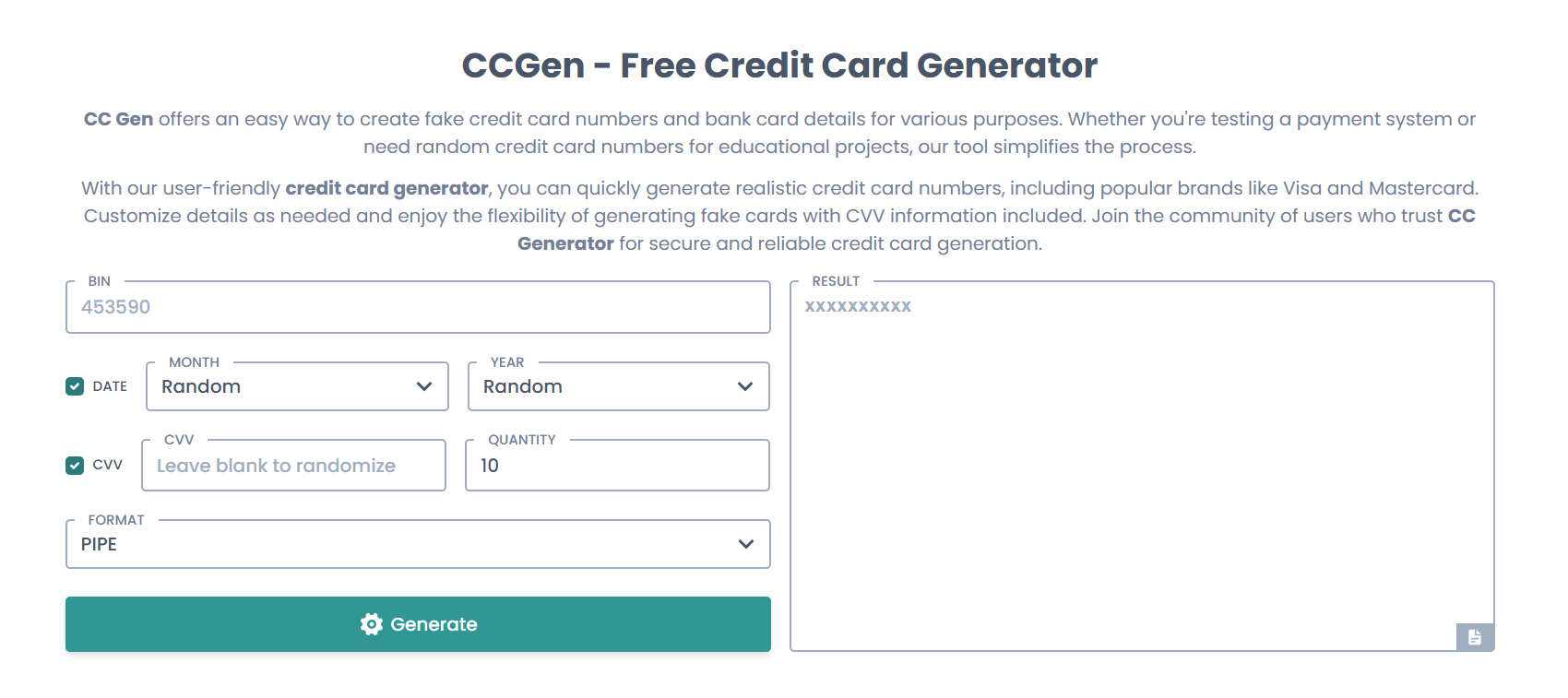Is CCGen Safe to Use for Testing Payments?

Testing payment gateways and e-commerce systems requires realistic data that won’t expose users or businesses to security risks. CCGen offers a free tool to generate fake credit card numbers that appear valid but are entirely safe. These numbers enable developers and testers to simulate transactions without relying on real financial data, thereby reducing risk and enhancing testing accuracy.
CCGen’s generated numbers adhere to industry standards, such as the Luhn algorithm, ensuring they pass common validation checks while remaining disconnected from actual accounts. This makes CCGen ideal for testing payment flows, fraud detection systems, and checkout processes without legal or privacy concerns.
Safety of Fake Credit Card Numbers
What Are Fake Credit Card Numbers?
Fake credit card numbers are randomly generated sequences that mimic the structure of real cards. They follow format rules and validation algorithms but are not tied to actual financial accounts. This makes them useful for testing without risking real money or data breaches.
Difference Between Fake and Real Card Numbers
Real credit cards are linked to accounts with funds and personal information. Fake numbers have no backing and cannot process real transactions. CCGen generates these fake numbers purposely to help developers test software securely.
Why Use Fake Numbers for Testing?
Using fake numbers prevents exposure of sensitive cardholder information during testing. It avoids accidental charges and complies with data privacy laws like PCI DSS. Fake cards allow repeated testing without financial consequences.
CCGen Ensures User Safety
No Storage of Personal or Payment Data
CCGen does not collect or save any personal or payment information from users. The card numbers are generated on the fly and displayed instantly without storing user inputs. This eliminates risks of data leaks or misuse.
Compliance with Legal and Ethical Standards
CCGen is designed strictly for ethical use, such as testing and education. It does not support or encourage fraud or illegal activities. Users are reminded that using generated numbers for real transactions is unlawful.
Secure Website and Data Transmission
The CCGen platform uses secure HTTPS protocols, ensuring encrypted data transmission. Users interact with the site in a protected environment that minimizes cybersecurity threats. This protects users from interception or attacks.
Risks and Limitations to Be Aware Of
Fake Numbers Cannot Be Used for Real Purchases
Though the numbers look valid, they cannot complete real transactions or access financial services. Attempting to use them on live systems will result in declined payments. This limitation protects against misuse.
Possible Misuse by Unethical Users
There is a risk that generated numbers could be attempted for fraudulent purposes, though they won’t work. CCGen discourages such use and monitors for abuse. Responsible use is critical to maintain safety.
Dependence on Proper Test Environment
CCGen numbers should only be used in controlled testing or staging environments. Using them in live environments can trigger errors or compliance issues. Proper separation of test and production is essential.
Safe Payment Testing with CCGen
Use Only in Test or Sandbox Environments
Always apply CCGen-generated card numbers in non-production systems designed for testing. Payment gateways usually offer sandbox modes specifically for this purpose. This prevents accidental real-world impact.
Avoid Storing Generated Numbers Publicly
Treat fake numbers like sensitive test data by restricting access and avoiding public exposure. This limits the chance of accidental misuse or confusion with real cards.
Regularly Update Testing Tools and Processes
Keep testing tools and environments updated with the latest versions and patches. CCGen itself is updated for 2025 standards, but integration with other tools should also be maintained. This ensures accuracy and security.
Advantages of Using CCGen for Safe Testing
Eliminates Risk of Real Data Exposure
By using fake, valid-looking cards, CCGen removes the risk of exposing real financial or personal data during testing. This significantly improves compliance with privacy regulations and internal policies.
Provides Instant and Unlimited Access
CCGen allows users to generate numerous card numbers instantly without sign-up or payment. This flexibility accelerates testing and enables thorough scenario coverage without barriers.
Summarizing Safety Benefits
- No real card data involved
- No registration or data collection
- HTTPS-secured platform
These factors combine to make CCGen a trustworthy choice for payment testing.
Real-World Use Cases
Testing Payment Gateways
Developers simulate credit card transactions using CCGen numbers to verify gateway functionality. This includes approval, decline, and error scenarios. Such testing is critical before live deployment.
E-commerce Checkout Simulations
Online stores test cart checkouts and payment flows with CCGen numbers to ensure smooth customer experiences. They verify validation logic, fraud detection triggers, and error handling.
Security and Fraud Detection Testing
Security teams use fake card numbers to evaluate fraud prevention systems. By simulating invalid or suspicious card data, they strengthen defenses against real threats.
Conclusion
CCGen offers a secure and ethical tool for generating fake credit card numbers ideal for payment testing. It protects user privacy by avoiding the storage of sensitive data and complies with legal standards. While the numbers cannot be used for real purchases, they provide authentic validation for software testing in controlled environments. Using CCGen responsibly ensures safe, cost-effective, and accurate payment system development.


